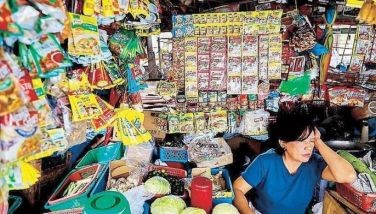Monsanto backs DA study of ‘freak’ rice harvest
March 24, 2003 | 12:00am
Monsanto Philippines officials recently said it is extending full support and cooperation to a study initiated by the Department of Agriculture (DA) on the below-par performance in some Northern Luzon areas by a high-yielding hybrid rice variety developed by the company.
Some farmers in Isabela recently reported that their harvest of the Magilas rice variety did not match the performance enjoyed by provinces in other parts of the country which planted the hybrid seeds.
Agriculture Secretary Luis Lorenzo Jr. immediately tasked the Philippine Rice Research Institute (PhilRice) to conduct a thorough study of the freak harvest in Isabela.
Lorenzo said the result of the study is crucial to the government’s program for increased rice production. He has also ordered various agencies under the DA to assist affected farmers in Isabela and some parts of Nueva Vizcaya.
Isabela farmers complained that their harvest of Magilas fell short of the average 4.5 to six metric tons per hectare which the variety yielded during its field trials in the country. They also asked why they did not harvest the five to 7.5 metric ton per hectare performance of Magilas enjoyed by rice farmers which commercially planted the variety in Agusan, Davao del Sur, South Cotabato and other provinces.
The government approved the domestic propagation of the Magilas hybrid rice variety following field trials which showed that it outperformed the open pollinated variety by up to more than 30 percent. The improved traditional variety yielded an average of 3.5 metric tons per hectare in irrigated fields and 2.5 metric tons per hectare in non-irrigated fields.
Monsanto earlier formed a fact-finding task force composed of agriculture experts to investigate the below-par performance of Magilas in some parts of Isabela and Nueva Vizcaya. Initial findings showed that the performance could have been caused by radical variations in climatic conditions in the affected localities.
"The wide range of temperature changes from late December to February this year could have affected the pollination process," the task force said.
"Tropical environments, such as the Philippines, experience a temperature range of 22 to 33 degrees Celsius, where 27 to 32 degrees Celsius is ideal for a good set in rice," the task force explained.
"The 16 to 18 degrees Celsius average during the past months in Northern Luzon may have, therefore, affected grain development adversely,"they pointed out.
The task force said it is making all its data available to PhilRice for further studies.
The data, particularly on climatic conditions, will also be compared to those gathered in the provinces where Magilas 500 performed above par. These are Agusan, Davao del Sur, South Cotabato, North Cotabato, and other provinces where there have been reports of very promising performance but waiting for the final harvest.
Monsanto said so far, the best performance of Magilas 500 this dry season planting was registered in Matanao, Davao del Sur by Salvador Deles in his six hectare rice farm with a yield of 7.5 metric tons per hectare.
Monsanto said that while the incident in some parts of Isabela and Nueva Vizcaya is isolated and is in stark contrast to the experience of farmers in other parts of the country, "it will be good to document the experience to avoid a repeat".
Some farmers in Isabela recently reported that their harvest of the Magilas rice variety did not match the performance enjoyed by provinces in other parts of the country which planted the hybrid seeds.
Agriculture Secretary Luis Lorenzo Jr. immediately tasked the Philippine Rice Research Institute (PhilRice) to conduct a thorough study of the freak harvest in Isabela.
Lorenzo said the result of the study is crucial to the government’s program for increased rice production. He has also ordered various agencies under the DA to assist affected farmers in Isabela and some parts of Nueva Vizcaya.
Isabela farmers complained that their harvest of Magilas fell short of the average 4.5 to six metric tons per hectare which the variety yielded during its field trials in the country. They also asked why they did not harvest the five to 7.5 metric ton per hectare performance of Magilas enjoyed by rice farmers which commercially planted the variety in Agusan, Davao del Sur, South Cotabato and other provinces.
The government approved the domestic propagation of the Magilas hybrid rice variety following field trials which showed that it outperformed the open pollinated variety by up to more than 30 percent. The improved traditional variety yielded an average of 3.5 metric tons per hectare in irrigated fields and 2.5 metric tons per hectare in non-irrigated fields.
Monsanto earlier formed a fact-finding task force composed of agriculture experts to investigate the below-par performance of Magilas in some parts of Isabela and Nueva Vizcaya. Initial findings showed that the performance could have been caused by radical variations in climatic conditions in the affected localities.
"The wide range of temperature changes from late December to February this year could have affected the pollination process," the task force said.
"Tropical environments, such as the Philippines, experience a temperature range of 22 to 33 degrees Celsius, where 27 to 32 degrees Celsius is ideal for a good set in rice," the task force explained.
"The 16 to 18 degrees Celsius average during the past months in Northern Luzon may have, therefore, affected grain development adversely,"they pointed out.
The task force said it is making all its data available to PhilRice for further studies.
The data, particularly on climatic conditions, will also be compared to those gathered in the provinces where Magilas 500 performed above par. These are Agusan, Davao del Sur, South Cotabato, North Cotabato, and other provinces where there have been reports of very promising performance but waiting for the final harvest.
Monsanto said so far, the best performance of Magilas 500 this dry season planting was registered in Matanao, Davao del Sur by Salvador Deles in his six hectare rice farm with a yield of 7.5 metric tons per hectare.
Monsanto said that while the incident in some parts of Isabela and Nueva Vizcaya is isolated and is in stark contrast to the experience of farmers in other parts of the country, "it will be good to document the experience to avoid a repeat".
BrandSpace Articles
<
>
- Latest
- Trending
Trending
Latest
Trending
Latest
Recommended































